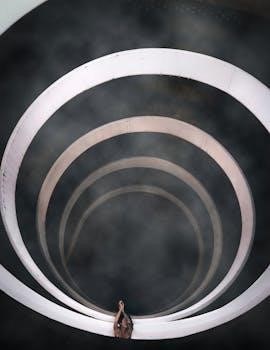
stroop effect test pdf
What is the Stroop Effect?
The Stroop Effect is a psychological phenomenon demonstrating a delay in reaction time when processing conflicting information. For example, naming the ink color of a word when the word itself is a different color proves difficult. This interference highlights automatic processing.
Definition and Basic Explanation
The Stroop effect, named after John Ridley Stroop, is a cognitive phenomenon that demonstrates interference in the reaction time of a task; Specifically, it occurs when there is a mismatch between the name of a color and the color in which it is printed. For instance, if the word “red” is printed in blue ink, naming the ink color (blue) takes longer than reading the word “red.” This delay is due to the brain’s automatic processing of word reading, which interferes with the less automatic task of identifying ink colors. The effect reveals the competition between these two cognitive processes.
The Original Stroop Test
The classic test involves participants naming the ink color of color words. These words may or may not match the ink color, creating congruent or incongruent conditions. This reveals reaction time differences.
Description of the Classic Color-Word Task
The standard version of the Stroop test presents participants with a list of color words printed in various ink colors. The task requires naming the ink color, not reading the word itself. For instance, the word “red” might be printed in blue ink, creating interference. Participants must quickly identify the ink color (“blue”) while suppressing the automatic tendency to read the word (“red”). This task highlights the conflict between reading and color naming, revealing the Stroop effect. The test measures how quickly and accurately individuals can resolve this cognitive conflict.

How the Stroop Effect Works
The Stroop effect arises due to cognitive interference between automatic reading and color identification. Reading is an automatic process, whereas naming colors is less automatic, leading to processing delays when they conflict.
Cognitive Interference and Automatic Processing
The Stroop effect vividly illustrates cognitive interference, a phenomenon where competing mental processes hinder each other. Our brains automatically process word meanings, a skill honed through years of practice. When the word’s meaning conflicts with the ink color, this automatic reading process interferes with the less automatic task of naming the color. This interference results in a slower reaction time and a higher likelihood of errors. The Stroop effect demonstrates the competition between these different processing pathways, revealing how automatic responses can impede controlled responses.
Variations of the Stroop Test
Numerous variations of the Stroop test exist, extending beyond color-word conflicts. Emotional Stroop tasks use emotional words, and numerical Stroop tasks involve number sizes, all exploring interference effects.
Emotional Stroop, Numerical Stroop and other modifications
Beyond the classic color-word paradigm, the Stroop test has been adapted in several ways. The Emotional Stroop variant uses emotion-laden words, like “anger” or “joy,” to assess how emotional content impacts interference. Participants name the ink color of these words, revealing attentional biases towards emotional stimuli. The Numerical Stroop involves incongruent number sizes, such as a large ‘2’ next to a small ‘8’, slowing comprehension. These modifications explore how different stimulus attributes create interference. Other variations incorporate different sensory modalities and variables to study specific effects.
Measuring Cognitive Functions with the Stroop Test
The Stroop test measures selective attention, processing speed, and executive function. It assesses the ability to inhibit cognitive interference, revealing how efficiently the brain handles conflicting information. This makes it a useful neuropsychological tool.
Selective Attention, Processing Speed, and Executive Function
The Stroop test is a valuable tool for assessing several key cognitive functions. It provides insights into an individual’s selective attention by measuring their ability to focus on relevant information while inhibiting distractions. Furthermore, the test gauges processing speed, reflecting how quickly someone can perform cognitive tasks. The Stroop effect also taps into executive function, a set of higher-level cognitive skills that include inhibitory control, cognitive flexibility and working memory. By analyzing performance on the Stroop test, researchers and clinicians can gain a better understanding of these crucial cognitive abilities.

Stroop Effect and Reaction Time
Incongruent stimuli in the Stroop test cause a significant increase in response time. This effect demonstrates the interference between automatic word reading and the less automatic color naming process.
How Incongruence Affects Response Time
The core of the Stroop effect lies in the incongruence between the word and its ink color, directly impacting reaction time. When the word “blue” is printed in red, our brains experience a conflict. The automatic process of reading interferes with the less automatic task of identifying the ink color. This conflict results in a noticeable delay in correctly naming the color. Studies consistently show that naming the ink color of incongruent words takes significantly longer than naming the color of congruent words or colored squares. This increased reaction time provides a clear measure of cognitive interference.
The History of the Stroop Effect
John Ridley Stroop first reported the effect in his 1935 Ph.D. thesis. His work detailed the interference observed when naming ink colors of conflicting color words, establishing a foundational concept in psychology.
John Ridley Stroop’s 1935 Research
John Ridley Stroop’s 1935 doctoral research laid the groundwork for understanding cognitive interference. His experiments involved presenting participants with color words printed in incongruent ink colors. Stroop meticulously documented the delayed reaction times when participants were asked to name the ink color rather than read the word itself. This groundbreaking work demonstrated that our brain processes word meanings more automatically than color identification; The observed delay is now famously known as the Stroop Effect, a cornerstone in the study of attention and cognitive processing.
Practical Applications of the Stroop Effect
The Stroop Effect has broad applications, including assessing cognitive abilities. It is used in research to study attention, processing speed, and executive functions. It also finds relevance in everyday life situations.
Examples in Research and Everyday Life
In research, the Stroop effect is utilized to study cognitive interference and automatic processing. It helps in understanding how the brain handles conflicting information, particularly in areas of attention and executive function. Variations of the test, such as the emotional Stroop, examine how emotional words impact reaction times. Everyday applications can be seen in situations requiring focused attention and quick decision-making, such as driving, where conflicting stimuli need rapid processing. The effect also highlights the automatic nature of reading, impacting tasks like proofreading where the meaning of words can interfere with noticing errors; It is also used to study the effects of training on information processing.

Stroop Test and Semantic Interference
The Stroop test demonstrates semantic interference because naming ink color is harder than reading the word itself. This occurs due to automatic word processing which interferes with the conscious task.
Why Naming Ink Color Is Harder Than Reading the Word
Naming the ink color in the Stroop test is more challenging than reading the word because reading is an automatic process, deeply ingrained in our cognitive system. Our brains are wired to process written language quickly and efficiently, making it difficult to suppress this automatic response. When confronted with a color word printed in a different color, the automatic reading response interferes with the less automatic task of identifying and naming the ink color. This conflict creates cognitive interference, resulting in slower reaction times and increased errors. This exemplifies how automatic processes can hinder deliberate actions.

How to Conduct a Stroop Test
To conduct a Stroop test, present participants with color words printed in different ink colors. Instruct them to name the ink color, not the word itself, as quickly as possible. Record their reaction times and errors.
Guidelines and Critical Steps
When conducting Stroop studies, adherence to specific guidelines is crucial for accurate results. Critical steps include ensuring clear instructions, consistent presentation of stimuli, and precise timing measurements. Variations in procedure are possible, but any departures from standard protocols should be carefully considered. Researchers should also be mindful of potential emotional influences, such as vocal cues, that could impact outcomes. Standardized protocols help maintain consistency across studies, allowing for reliable comparisons and conclusions. Detailed recording of errors and reaction times is essential for a comprehensive analysis of the effect.
The Stroop Test in PDF Format
Printable Stroop tests are readily available in PDF format online. These resources allow for easy administration of the test, offering a convenient tool for both research and educational purposes.
Availability of Printable Stroop Tests
Numerous websites offer downloadable Stroop tests in PDF format, making them easily accessible for various uses. These printable versions often include standard color-word lists and instructions, facilitating consistent administration. Researchers, educators, and individuals can utilize these resources for cognitive assessments, demonstrations, or personal exploration of the Stroop effect. The availability of these tests online allows for convenient practice, research, or experimentation without requiring specialized equipment. These PDFs may include variations on the classic Stroop task, offering different challenges. It’s convenient to find a variety of materials this way.
Modifications and Research Directions
The classic Stroop test has been modified to explore bilingualism, emotions, and other factors. Research continues to investigate brain activity during the task, as well as the influence of training.
Exploring Bilingualism, Emotions, and Other Factors
The Stroop test’s adaptability allows for investigations into various cognitive influences. Researchers explore how bilingualism affects interference, with studies examining whether the effect differs across languages. The emotional Stroop task, using emotionally charged words, reveals how emotional content impacts processing speed. Moreover, variations delve into other sensory modalities and variables. Further studies analyze how practice, training, and even factors like age influence the Stroop effect, making it a versatile tool for cognitive research. These diverse investigations broaden our understanding of cognitive interference and its neural underpinnings.